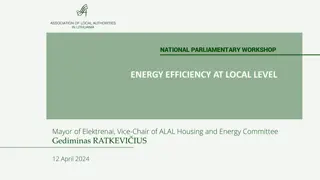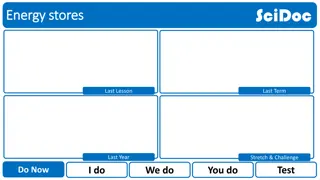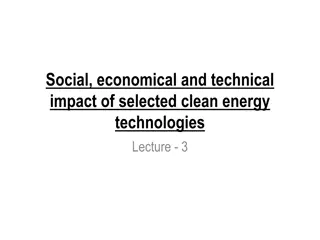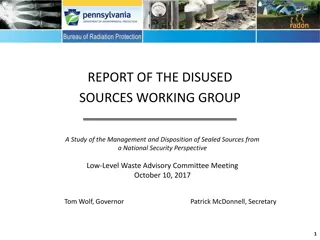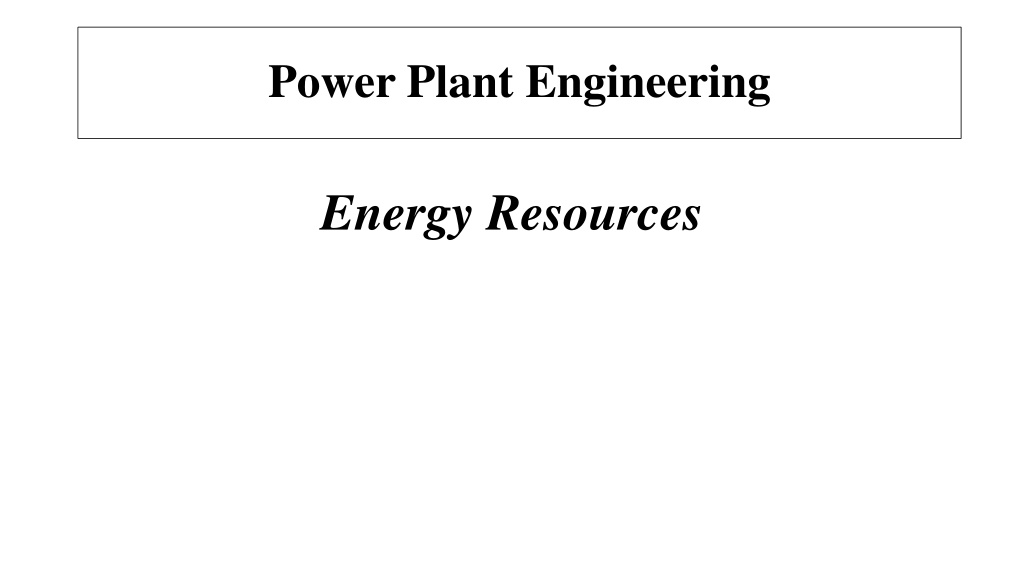
Understanding Conventional Energy Sources and Nuclear Power
Learn about conventional energy sources like coal, petroleum, and natural gas, their advantages, disadvantages, and the non-renewable nature of nuclear power. Discover how energy is classified and the impact of these energy sources on the environment and global warming.
Download Presentation

Please find below an Image/Link to download the presentation.
The content on the website is provided AS IS for your information and personal use only. It may not be sold, licensed, or shared on other websites without obtaining consent from the author. Download presentation by click this link. If you encounter any issues during the download, it is possible that the publisher has removed the file from their server.
E N D
Presentation Transcript
Power Plant Engineering Energy Resources
Energy Energy is the capacity of a physical system to perform work. Energy exists in several forms such as heat, kinetic or mechanical energy, light, potential energy, electrical, or other forms. Energy can be classified into several types based on the following criteria: Primary and Secondary energy Commercial and Non commercial energy Conventional and Non-conventional energy
Conventional Energy Sources The term "Conventional" means "not unusual or extreme or ordinary." Conventional energy sources are the traditional sources of energy like coal and petroleum. Conventional energy sources are finite. They will not last forever.
Conventional Energy Sources Natural Gas Natural gas in its purest form is pure methane but before it is refined, it also contains varying amount of ethane, propane, butane and carbon dioxide. When refined, it is colorless and odorless but can be burned to release large amounts of energy. Petroleum Petroleum is formed from the compression of animal and plant remains over millions of years. Petroleum has to be drilled for because it is usually located deep below the earth's surface and is then refined to produce a number of different products including gasoline, heavy fuel oil and diesel fuel. Coal Coal releases large amounts of energy when it is burned because of the density of hydrocarbons in the material. Coal is formed by dead plants being put under significant pressure and temperature for millions of years. There are four grades of coal: lignite, subbituminous, bituminous coal and anthracite. Bituminous coal is the best for releasing energy and is the most commonly mined type of coal.
Nuclear Power Nuclear power is not a fossil fuel but it is a non-renewable form of energy. Nuclear power is considered non-renewable because the material used in nuclear power plants uranium is a non- renewable resource. Nuclear energy is generated from the energy released when atoms of uranium are split during the process of nuclear fission in a nuclear reactor. The type of uranium used for nuclear energy is U- 235. Uranium is extracted from rock and then enriched to become uranium 235 isotope before being made into pellets that are loaded into assemblies of nuclear fuel rods.
Advantages and Disadvantages of Conventional Energy Advantages: It can provide energy regardless of the weather conditions unlike solar and wind power which may go for days without being able to produce substantial amounts of power. Currently, the financial costs are much lower than alternative energy sources. Disadvantages: Petroleum, gas and coal are non renewable energy sources which means that they will eventually run out. These energy sources also release greenhouse gases like carbon dioxide into the atmosphere which contribute to global warming. Other pollutants released include sulfur and nitrogen oxide, which can lead to acid rain and mercury, which is harmful to humans when ingested.
Fossil Fuels Solid Fuel Liquid Fuel Gaseous Fuel Wood: Includes firewood, charcoal, woodchips, pellets, sawdust, and so on. Petroleum: The most common type of liquid fuel is petroleum, formed from dead plants and animals Gasoline/petrol: Produced by removing crude oil from petroleum and distilling it in refineries. Natural gas: The most commonly used type, but there are numerous manufactured fuel gases Charcoal: Produced by heating wood in the absence of oxygen. Coal gas: Derived from coal Diesel: A mixture of aliphatic hydrocarbons extracted from petroleum, and processed to reduce the sulphur level. Biomass: Natural plant materials, such as wheat, straw and other fibrous material. Water gas: A mixture of carbon monoxide and hydrogen produced from synthetic gas. Kerosene: Extracted from petroleum. Peat: Organic matter and decayed vegetation that can be burned when dry. Syngas: Synthetic gas consisting of hydrogen, carbon monoxide, and often carbon dioxide. Biogas:A mixture of gases derived from organic matter breaking down in the absence of oxygen. Liquefied petroleum gas: a mixture of propane and butane, and is more easily compressed than natural gas. Coal: Combustible sedimentary rock. Biodiesel: diesel fuel based on vegetable oil or animal fat Methanol: Produced from methane, methanol is the lightest and simplest form of alcohol. Ethanol: Most commonly found in drinks, but can be combined with gasoline for use as a fuel.
Solid Fuel Advantages of solid fuels : They are easy to transport. They are convenient to store without any risk of spontaneous explosion. Their cost of production is low. They possess moderate ignition temperature. Disadvantages of solid fuels : Their ash content is high. Their combustion operations cannot be controlled easily. Their cost of handling is high. Their large proportion of heat is wasted during combustion. Their thermal efficiency is low. Their calorific value is lower as compared to that of liquids fuels. They require large excess of air for complete combustion.
Liquid Fuel Advantages of liquid fuels They possess higher calorific value per unit mass than solid fuels. They burn without forming dust, ash etc. Their firing is easier and also fire can be extinguished easily by stopping the liquid fuel supply. They are clean in use and economic in labour. Loss of heat to chimney is very low due to greater cleanliness. They require less excess of air for complete combustion. Disadvantages of liquid fuels The cost of liquid fuel is relatively much higher as compared to solid fuels. Costly special storage tanks are required for storing liquid fuels. There is greater risk of fire hazards, particularly in case of highly inflammable and volatile liquid fuels.
Gaseous Fuel Advantages of Gaseous fuels They can be pre-heated by the heat of hot waste gases, thereby affording economy in heat. They burn without any smoke. They are ash less so there is no labor involved in ash handling. They burn in slight excess of air supply. They are free from solid and liquid impurities. Complete combustion without pollution is possible due to uniform mixing of air and fuel. They have high calorific value as well. Disadvantages of Gaseous fuels Very large storage tank needed for them. They are highly inflammable, so chances of fire hazards are high in their use. They are more costly as compared with solid and liquid fuels.
Renewable Energy Sources Renewable energy is natural energy which does not have a limited supply. Renewable energy can be used again and again, and will never run out. Renewable energy is energy which comes from natural resources such as sunlight, wind, rain, tides and geothermal heat, which are renewable (naturally replenished.) Renewable energy is an alternative to fossil fuels and nuclear power, and was commonly called alternative energy.
Wind Power Airflows can be used to run wind turbines. Modern wind turbines range from around 600 kW to 5 MW of rated power, although turbines with rated output of 1.5 3 MW have become the most common for commercial use; the power output of a turbine is a function of the cube of the wind speed, so as wind speed increases, power output increases dramatically. Areas where winds are stronger and more constant, such as offshore and high altitude sites, are preferred locations for wind farms. Typical capacity factors are 20- 40%, with values at the upper end of the range in particularly favorable sites.
Hydropower Flowing water creates energy that can be captured and turned into electricity. This is called hydroelectric power or hydropower. The most common type of hydroelectric power plant uses a dam on a river to store water in a reservoir. Water released from the reservoir flows through a turbine, spinning it, which in turn activates a generator to produce electricity. But hydroelectric power doesn't necessarily require a large dam. Some hydroelectric power plants just use a small canal to channel the river water through a turbine.
Solar Energy Solar energy is the energy derived from the sun through the form of solar radiation. Solar powered electrical generation relies on photovoltaic and heat engines. A partial list of other solar applications includes space heating and cooling through solar architecture, day lighting, solar hot water, solar cooking, and high temperature process heat for industrial purposes. Solar technologies are broadly characterized as either passive solar or active solar depending on the way they capture, convert and distribute solar energy.
Biomass Biomass (plant material) is a renewable energy source because the energy it contains comes from the sun. Through the process of photosynthesis, plants capture the sun's energy. When the plants are burned, they release the sun's energy they contain. In this way, biomass functions as a sort of natural battery for storing solar energy. As long as biomass is produced sustainably, with only as much used as is grown, the battery will last indefinitely. In general there are two main approaches to using plants for energy production: growing plants specifically for energy use, and using the residues from plants that are used for other things. The best approaches vary from region to region according to climate, soils and geography.
Tidal Energy Ocean waves and tides contain large amount of energy. Such tides rise and fall and water can be stored during rise period and it can be discharged during fall. Due to low head of water available low head hydroelectric plants can work successfully. These plants can utilize a head of just a few meters. During high tide the height of tide is above that of tidal basin and turbine unit operates and generates power. During low tide the height of tide is lower than that of the tidal basin. At this time water is allowed to flow out to drive the turbine unit. The turbine unit does not operate if the tide sea level and basin level are equal.
Biofuel Liquid biofuel is usually either bio alcohol such as bioethanol or an oil such as biodiesel. Bioethanol is an alcohol made by fermenting the sugar components of plant materials and it is made mostly from sugar and starch crops. With advanced technology being developed, cellulosic biomass, such as trees and grasses, are also used as feedstock for ethanol production. Biodiesel is made from vegetable oils or animal fats. Biodiesel can be used as a fuel for vehicles in its pure form, but it is usually used as a diesel additive to reduce levels of particulates, carbon monoxide, and hydrocarbons from diesel-powered vehicles.
Geothermal Energy Geothermal energy is energy obtained by tapping the heat of the earth itself, both from kilometers deep into the Earth's crust in volcanically active locations of the globe or from shallow depths, as in geothermal heat pumps in most locations of the planet. It is expensive to build a power station but operating costs are low resulting in low energy costs for suitable sites. Ultimately, this energy derives from heat in the Earth's core.
Advantages of Renewable Energy Sources Renewable energy sources consist of solar, hydro, wind, geothermal, ocean and biomass. The most common advantage of each is that they are renewable and cannot be depleted. They are clean energy, as they don't pollute the air, and they don't contribute to global warming or greenhouse effects. Since their sources are natural the cost of operations is reduced and they also require less maintenance on their plants.
Disadvantages of Renewable Energy Sources A common disadvantage to all is that it is difficult to produce the large quantities of electricity their counterpart the fossil fuels are able to. Since they are also new technologies, the cost of initiating them is high. Wind: turbines are expensive. Wind doesn't blow all the time, so they have to be part of a larger plan. Solar :panels are expensive. Governments are not all willing to buy home generated electricity. Not all climates are suitable for solar panels. Tides : barrages (dams) across river mouths are expensive to build and disrupt shipping. Smaller turbines are cheaper and easier to install. Rivers : Dams are expensive to build and disrupt the environment. They have also caused earthquakes. Geothermal : Difficult to drill two or three kilometers down into the earth. Biofuel : Often uses crop lands and crops (like corn) to produce the bio-alcohol. This means that more land has to be cleared to grow crops, or there is not enough food, or that food becomes more expensive
Calorific Value of Fuel The amount of heat produced by the complete combustion of a unit weight of fuel is known as its calorific values. Calorific value indicates the amount of heat available from the fuel. The greater the calorific value of fuel, the larger is its ability to produce heat. In case of solid and liquid fuels, the calorific value is expressed in cal/gm or kcal/kg. However, in case of gaseous fuels, it is generally stated in cal/litre or kcal/litre.
Calorific Value of Fuel The calorific value of a fual can be classified into two Ways (i) Higher calorific value (H.C.T) (ii) Lower calorific value (L.C.T) The higher or gross of calorific value is the total amount of heat produced when unit quantity of fuel is burnt completely and the products of combustion have been cooled to room temperature generally 15 C. The lower calorific value is the net amount of heat produced when unit quantity of fuel is completely burnt and the products of combustion are not cooled to room temperature but are allowed to escape
Higher Calorific Value of Fuel According to Dulong Formula the calorific value of a fuel can be calculated as: where C, H, O and S represent the percentage by weight of Carbon, hydrogen, Oxygen and Sulphur respectively.
Lower Calorific Value of Fuel The net or Lower calorific value(L.C.V.) is obtained by subtracting from H.C.V. the heat carried by the products of combustion especially by steam which can taken as 588.76 kcal/kg of water vapours formed due to burning of 1 kg of fuel. So, L.C.V. = (H.C.V - 588.76 x W) kcal/kg. where W is the amount of water vapours formed by the combustion of 1 kg of fuel.
Practice Problem Example 1.6 : The percentage composition by weight of a sample of coal is given as below. C=65.50%; H2=6.65% 02= 17.50%; S= 1.80% Using Dulong formula, calculate the calorific value of coal.
Practice Problem Example 1.10. A sample of coal has the following composition by weight C = 70%, Hydrogen 8%, nitrogen 3%, oxygen 7%, sulphur 2% and ash 10%. Determine the higher calorific value and lower calorific value of fuel.





